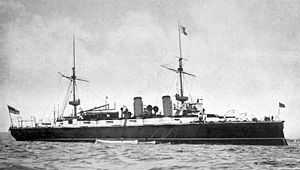HMS Orlando (1886)
 | |
| Career (United Kingdom) | |
|---|---|
| Name: | HMS Orlando |
| Builder: | Palmers Shipbuilding and Iron Company, Jarrow |
| Laid down: | 23 April 1885 |
| Launched: | 3 August 1886 |
| Fate: | Sold for breaking up 11 July 1905 |
| General characteristics | |
| Class and type: | Orlando-class armoured cruiser |
| Displacement: | 5,600 tonnes (5,500 long tons) |
| Length: | 300 ft (91 m) p/p |
| Beam: | 56 ft (17 m) |
| Draught: | 22.5 ft (6.9 m) |
| Installed power: | 5,500 hp (4,100 kW) 8,500 hp (6,300 kW) forced-draught |
| Propulsion: | 3-cylinder triple-extension steam engines two shafts 4 double-ended boilers |
| Speed: | 17 knots (31 km/h) natural draught 18 knots (33 km/h) forced draught |
| Range: | 10,000 nautical miles (19,000 km) at 10 knots (19 km/h) |
| Complement: | 484 |
| Armament: |
|
| Armour: | Belt: 10 in (250 mm) Conning tower: 12 in (300 mm) |
HMS Orlando was the lead ship of the Orlando class of first-class cruisers built in the yards of Palmers Shipbuilding and Iron Company, Jarrow and launched on 3 August 1886.
Service history
She was commanded by Charles Ramsay Arbuthnot on the Australia Station from 1892 to 1895. In 1899 she was assigned to the China Station,[1] Captain James Henry Thomas Burke in command. During the Boxer Rebellion in 1900, sailors from HMS Orlando formed part of the force led by Vice-Admiral Sir Edward Seymour attempting to relieve the British Legation in Beijing. A replica of a bell captured from the Taku Forts forms part of a memorial to HMS Orlando in Victoria Park, Portsmouth.
In late March 1902 she left Hong Kong for Singapore, arriving there on 6 April.[2] After three weeks, she left Penang in late April, homebound,[3] stopping at Colombo on 5 May,[4] Aden on 14 May,[5] and Malta before arriving home in late May. Captain Burke died at sea on 12 May 1902, during the journey, and was buried at Aden.[6]
HMS Orlando was sold for scrapping on 11 July 1905 to Ward of Morecambe for £10,000.[1]
Notes
- ↑ 1.0 1.1 Bastock, pp.98–99.
- ↑ "Naval & Military intelligence" The Times (London). Wednesday, 9 April 1902. (36737), p. 10.
- ↑ "Naval & Military intelligence" The Times (London). Wednesday, 30 April 1902. (36755), p. 9.
- ↑ "Naval & Military intelligence" The Times (London). Wednesday, 7 May 1902. (36761), p. 10.
- ↑ "Naval & Military intelligence" The Times (London). Friday, 16 May 1902. (36769), p. 11.
- ↑ "Obituary - Captain James Burke" The Times (London). Saturday, 17 May 1902. (36770), p. 8.
References
- Bastock, John (1988), Ships on the Australia Station, Child & Associates Publishing Pty Ltd; Frenchs Forest, Australia. ISBN 0-86777-348-0
- Colledge, J. J.; Warlow, Ben (2006) [1969]. Ships of the Royal Navy: The Complete Record of all Fighting Ships of the Royal Navy (Rev. ed.). London: Chatham Publishing. ISBN 978-1-86176-281-8. OCLC 67375475.
- Roger Chesneau and Eugene M. Kolesnik, ed., Conway's All The Worlds Fighting Ships, 1860–1905, (Conway Maritime Press, London, 1979), ISBN 0-85177-133-5
External links
| Wikimedia Commons has media related to HMS Orlando (1886). |
- http://www.memorials.inportsmouth.co.uk/city-centre/orlando.htm
- http://www.battleships-cruisers.co.uk/hms_orlando.htm
| ||||||||||